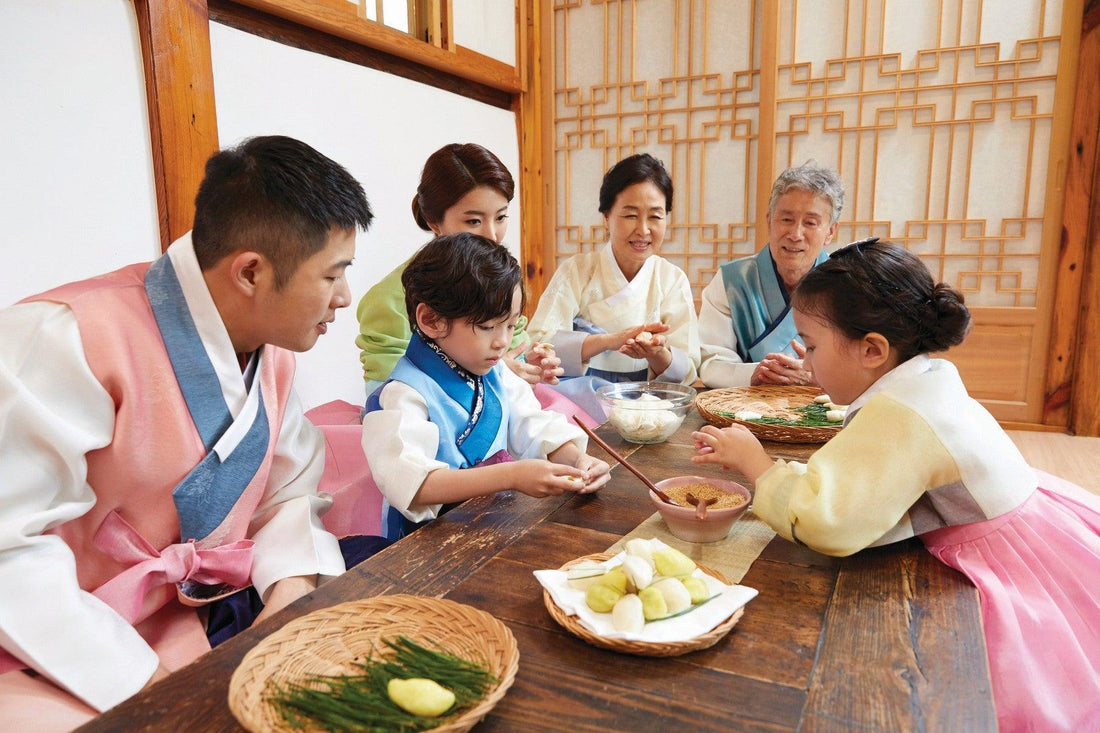Celebrated annually, over a course of three days, Chuseok is the Korea's equivalent of Thanksgiving here in the States. It's a national holiday, full of giving, sharing and gathering, to celebrate the coming of autumn and to pay respect to familial ancestors.
Chuseok (추석), which literally means “autumn eve,” is the biggest holiday of South Korea that is celebrated on the 15th day of the 8th month of the lunar calendar. This three-day holiday is a time when 75% of the nation’s population goes on a mass migration of sorts every year, traveling to their ancestral hometowns to see family and loved ones. Commonly called the Korean Thanksgiving, it has traditionally been a holiday when families gather to hope for a successful autumn harvest and pay their respect of thanks to their ancestors.
Origins and Traditions of Chuseok
The exact origin of this holiday is not clear, but it is assumed to have started before the Three Kingdoms Era of Korea. Many scholars believe it may have originated from ancient shamanistic celebrations of the harvest moon, perhaps as a worship ritual. Regardless of the truth, Chuseok has undoubtedly been an essential holiday for Korea that has been an agricultural society since a very long time ago.
Chuseok has been, and it still is, a time for families to get together, share food and goodwill, and give thanks to their ancestors. It is customary to wear traditional attire and perform ancestral worship rituals early in the morning called charye (차례), which stems from the Confucian idea of filial piety. As a symbolic expression of their continued dedication to their ancestors even after their death, descendants prepare an offering table of food of rice, soup, songpyeon (송편), small, half-moon-shaped chewy cakes made with newly harvested rice, new autumn fruits, vegetable and meat dishes, and alcoholic drinks, set to a specific arrangement of placement based on the four directions.
Although the kinds of food and placement order may vary across regions and periods, the rite stems from the traditional idea of spiritual life after physical death and the belief that the appeased spirits of the ancestors will bestow good fortune, protection, and a successful harvest to the descendants. The Confucian tradition teaches people to share any such benefits received with family, friends, and neighbors, which is why Chuseok has always been not just a family holiday, but a village festival, sharing food, playing games and sports, singing, and dancing.
During the Chuseok holiday, people go on seongmyo (성묘) to visit the ancestral grave sites to pay their respects, especially their immediate ancestors, at which time they perform beolcho (벌초), which is the trimming of grass and removing of weeds around the gravesite.
Villages and towns traditionally held many events and games during Chuseok and were almost always filled with nongak (농악), the festive rhythmic music performed by farmers. There would be crowds gathered to spectate bull or cock fights. On grass or sand fields, you’d see tournaments of ssireum (씨름), a sport assumed to have originated 5,000 years ago where two players wrestle each other holding on to the opponent’s band around the waist. The winner was given a prestigious title of being “the most powerful” and a calf, large sacks of rice, etc., as the prize. Tugs-of-war between village residents broke out or even escalated to become a match of pride between villages. Come nighttime, women made huge circles holding hand in hand to dance the ganggangsullae (강강수월래) under the full moon. People gathered in groups holding torchlights and climbed hills for dalmaji (달맞이), literally to greet the Chuseok moon as the name suggests. In contemporary South Korea, these folk games are no longer prevalent and are usually held as special events, although ssireum remains quite a popular sport among the young and the old.
The Gift-Giving of Chuseok
Gift-giving is an essential custom of Chuseok of modern times. People take the opportunity to show their appreciation to family and friends, and important people, both personal and work-related. Companies give gifts to employees. In the 1960s, people used to share daily necessities such as sugar, soap, or condiments, but as the economy developed, so did gift options.
In the 21st century, gifts have become more sophisticated, with people opting to give electronic devices and special sets of premium foods, such as Hanwoo 한우 (Korean beef), rice, special jang (장), aka fermented foods like Gochujang and Doenjang), jeotgal (젓갈), or salted fish. Sons and daughters provide gifts of cash to parents, and parents always make sure their visiting children leave with their hands full of food.
Speaking of food, along with corn and wheat, rice is one of the three primary crops of the world, cultivated in areas of Asia since ancient times. Rice has been an important crop for Korea, permeating various aspects of life and playing an integral part in shaping the culture and history of the traditional agricultural society.
Being Korea’s star crop, it’s no wonder that rice and rice farming is an essential part of Chuseok, the harvest festival, along with many other Korean holidays and traditions. The festival itself is about wishing for bountiful rice crops come harvest time. Songpyeun, the half-moon-shaped Korean rice cake made during this holiday, is made from freshly harvested rice. Rice is a required element when setting the food-offering ritual charye table to the ancestors. The liquor that is drunk on Chuseok is baeksaeju (백세주), which is also made from new rice. Along with hundreds of other Korean liquors, soju (소주) is another rice-based drink that is often drunk during holidays, put on the charye table, and sprinkled on graves during seongmyo. During the holiday festivities, the winner of the ssireum contest was given sacks of rice.
Celebrating Chuseok Today
These days, however, the focus of the holiday is mainly about visiting family and showing appreciation to special people, as busy modern lives seldom allow such large gatherings or visits, which can be barely once a year for some. This may be why people are willing to endure the clogged highways and book their train tickets months in advance to travel the lengths to visit family.
Younger people who are less bound by familial obligations and time in the kitchen (for all that food preparation) enjoy binging on their favorite series and meeting friends. Also, taking long vacations is relatively tricky due to the Korean work environment and customs, so the three-day Chuseok holiday and a couple of personal days plus the weekend (if lucky) can make it the perfect time for many people to travel to foreign countries (during pre-COVID-19 days).
(Photo credit: https://www.korea.net/AboutKorea/Korean-Life/Festivals)
Keywords: South Korea, Korean food, Korean culture, Chuseok


